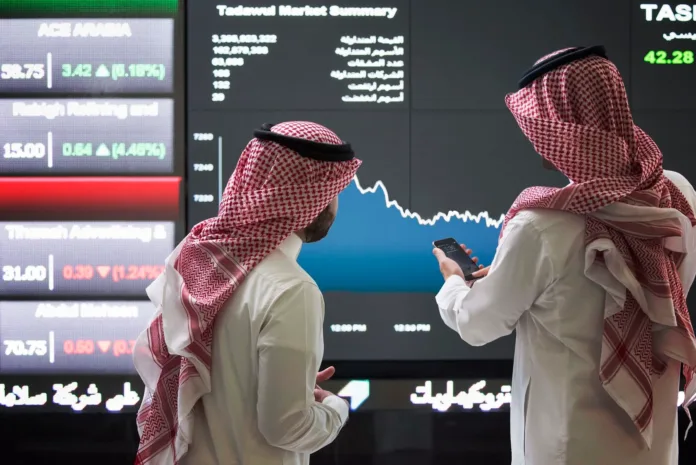The Article Tells The Story of:
- Saudi Arabia stocks rise sharply while global markets plunge. Why the split?
- Major indices from Asia to Europe crashed hard—but TASI climbed.
- Top Saudi companies gained big as oil prices dropped.
- Is Saudi Arabia becoming a safe zone while markets worldwide burn?
Saudi Arabia Defies Global Market Crash With Monday Gains
Global markets faced sharp losses on Monday, April 7, as traders responded to growing fears over rising tariffs and trade war threats. However, Saudi Arabia’s stock market stood out with a surprising move in the opposite direction. While major indices in Asia and Europe posted some of their biggest losses of the year, the Tadawul All Share Index (TASI) rose steadily during the day’s trading session.
This contrast has drawn attention from investors and analysts worldwide. What caused Saudi Arabia’s markets to gain while others dropped? Let’s look at the numbers and the factors behind this unexpected surge.
Read More About Our Article of Dow’s Historic Crash: Will Trump’s Tariffs Trigger a 2025 Financial Meltdown? Published on March 7, 2025 SquaredTech
TASI Moves Higher Amid Global Panic
The Tadawul All Share Index, Saudi Arabia’s key benchmark, traded 0.67% higher at 11,151.20 points as of early afternoon (GMT). The previous market close had TASI at 11,077.19 points. This move upward came as global markets were deep in the red.
This rise surprised many traders who expected the negative sentiment from international markets to spill over into the Middle East. Instead, the Saudi stock market showed strong resilience, supported by domestic developments and select company performances.
Key Gainers and Losers in the Saudi Market
Some of the top performers in the Saudi stock exchange on Monday included:
- National Company for Learning and Education (NCLE)
- Jahez International Company for Information System Technology (JAHEZ)
- Etihad Etisalat Co.
- Dr. Sulaiman Al Habib Medical Services Group
- Yanbu Cement Co. (YCC)
These stocks helped push the TASI index higher as investors looked for safety and value in local companies with strong fundamentals.
Meanwhile, some companies did post losses during the session. According to official data from the Saudi Exchange, the top laggards included:
- Nama Chemicals Co.
- Batic Investments and Logistics Co.
- Red Sea International Co.
- MBC Group Co.
- Raydan Food Co.
Despite some declines, the broader market trend in Saudi Arabia remained positive for the day.
Oil Price Cut May Have Boosted Sentiment
One key factor that may have supported investor sentiment in Saudi Arabia was the country’s decision to cut oil prices for Asian buyers. Late Sunday, April 6, Saudi Arabia reduced its oil price by $2.30 per barrel for May shipments, according to Bloomberg.
Lower oil prices could support stronger demand in the region, which may have helped lift stocks tied to oil-related sectors or industries that benefit from cheaper energy.
This move also showed Saudi Arabia’s efforts to stay competitive in the energy market, especially as global demand faces uncertainty due to economic risks and trade disputes.
Global Markets Sink Under Tariff Pressure
While Saudi Arabia stocks posted gains, global markets saw sharp declines due to rising fears over trade tensions. President Trump’s aggressive tariff announcements have rattled financial markets, with many investors selling off risk assets.
In Asia:
- The Hang Seng Index in Hong Kong dropped over 3,000 points. It closed 13.22% lower at 19,828.30 points from its last close of 22,849.81 points.
- Japan’s Nikkei 225 Index lost more than 2,600 points, closing down 7.83% at 31,136.58 points from 33,780.58 points.
In Europe:
- Germany’s DAX Index dropped 1,100 points in early trading. It was down 3.92%, trading at 19,828.23 points.
- The UK’s FTSE 100 Index crashed over 5% at the open. It later traded 3.83% lower at 7,746.56 points.
Investors across continents sold heavily amid fears that the U.S.-China trade war could grow worse, hurting global economic growth and driving inflation higher.
Market Volatility Continues Worldwide
The sharp market swings seen on Monday are part of a broader trend of rising volatility. Global investors are reacting to headlines, social media updates, and policy changes almost in real-time. Speculation about possible pauses or escalations in tariffs continues to drive large intraday movements.
In the U.S., major stock indices have also seen record swings, with fears of recession and inflation pushing investors toward safer assets. The uncertainty has led to a sharp drop in risk appetite globally.
Why Saudi Arabia Stocks Stand Out
Saudi Arabia’s stock market gains appear to be driven by a mix of local investor confidence, support from oil-related news, and the performance of specific companies. While the rest of the world was focused on global risks, investors in the Kingdom may have seen an opportunity to buy strong local assets at steady prices.
The TASI index’s rise could also reflect efforts by domestic institutions to provide stability or capitalize on weakness in global sentiment. With fewer international investors in the Saudi market compared to other global indices, local trends often have a bigger impact on short-term moves.
Final Thoughts: A Market to Watch
Saudi Arabia’s stock market showed strength on a day when most global indices suffered heavy losses. This contrast highlights how regional factors, such as energy pricing and domestic business confidence, can help a market outperform during global downturns.
While the global trade situation remains tense and uncertain, the TASI’s performance on Monday offers a rare bright spot for investors looking for relative strength.
As global volatility continues, all eyes will be on how long Saudi Arabia can maintain this momentum—and whether other markets might follow its lead in the days ahead.
Stay Updated: Tech News


